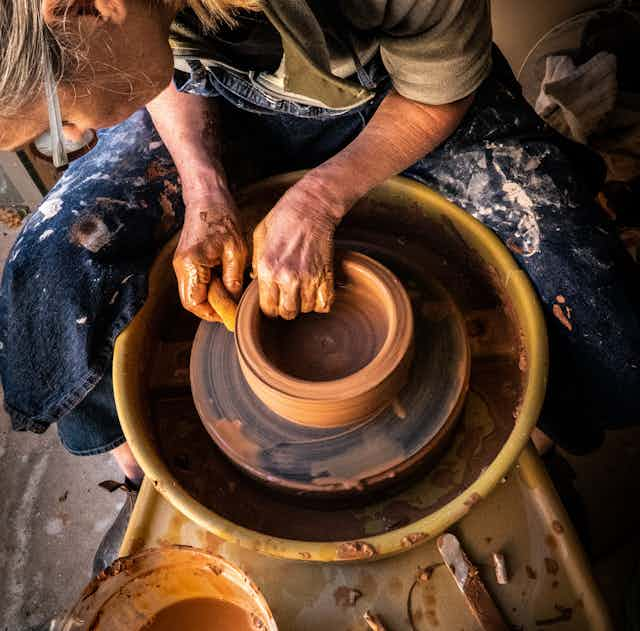When Arts Minister Tony Burke launched the bill introducing Creative Australia, the new organisation at the heart of the Revive Cultural Policy, he did so with a bold statement:
Creative Australia recognises that artists and creatives throughout our great landscape, from metropolitan cities to the red desert, are workers. In exchange for what they give us, they should have safe workplaces and be remunerated fairly.
In 2022, we surveyed 702 visual and craft artists and arts workers, making this the largest single scholarly survey of this cohort in Australia to date. We were interested to find out the ways artists combined income from various sources, within and beyond their art practice.
Our new research identifies three key areas that need to be addressed to ensure fair remuneration for all visual and craft artists. We need to acknowledge the likely under-counting of the number of artists in Australia, the gendered nature of this population, and the complex ways artists earn an income.
Counting the artists
It is impossible to provide a single estimate of the number of visual and craft artists in Australia as different surveys use different definitions of “artist”.
According to the 2021 ABS census, there are 6,793 visual art and craft professionals in Australia, 64% of whom identified as female.
But the criteria used to count being an artist as a profession in the census require art to be the “main job” of the respondent in the week before the census. This leads to an under-counting of artists, as most visual art and craft artists support themselves through other work – either related to their artwork, such as in academia or in arts management, or in an entirely different field. As such, they would not be identified in the census as visual or craft artists.

A more accurate estimate is likely provided by the ABS Survey of Cultural Participation. In this survey, 106,000 Australians reported earning some income from a visual art activity, and 94,800 from a craft activity, in the 2021–22 financial year. These figures cannot be totalled as those engaged in both activities were counted separately. Nonetheless, at a minimum the survey identifies an additional 100,000 visual and craft artists not captured within the census definition.
If all artists are to be remunerated fairly, it is critical Creative Australia ensures support mechanisms extend to the around 100,000 visual and craft artists for whom art making is not their primary occupation.
The gendered nature of the industry
In our survey, we did not impose any requirements that respondents devote a certain amount of time to their art making, nor earn a particular level of income. Instead, we left it open to respondents to self-identify as an artist.
This inclusive definition produced a much higher proportion of female artists than the census, with 73% identifying as female. This aligns with other estimates of the gender breakdown of the industry. The ABS Cultural Participation Survey estimated 67% of people who earned income from visual art activity and 79% who derived income from craft activity were female.
In our survey, 3.1% of respondents identified as non-binary, and so we were not able to collect enough data for further analysis of this cohort.
We found a distinctive experience of female artists compared to their male counterparts, suggesting policy responses need to recognise the gendered nature of art making.
Female artists in our survey reported an average annual income of A$8,507 from their arts practice, compared to the annual income reported by male artists of $22,906.
While earning 37% of male artists’ earnings, women spent 76% of the time male artists spend on their practice (29 hours compared with 38 hours per week).

So, male artists earn more from their art practice than female artists, and proportionately even more when accounting for the hours spent on their practice.
Our research suggests the shadow cohort of visual and craft artists who do not show up in census results are predominantly female. The gendered nature of the visual arts and craft sector must be front of mind in the design of remuneration policies for artists undertaken by Creative Australia.
Read more: The gender pay gap is wider in the arts than in other industries
How artists earn a living
For many artists, the practice of visual art and craft making does not readily align with traditional concepts of an employee and is not attached to a single workplace.
In our survey, only 30% of respondents spent 100% of their working time as an artist, with 60% receiving at least some income from non-artistic work within and outside the arts sector.
The life of an artist is more likely to look like a combination of multiple part-time, casual and contract jobs, with occasional grant income and artwork sales.
Many visual art and craft artists conduct their practice from their home and operate as a sole trader. For many, outside work is the only way they can support their art practice.

Achieving the goal of remunerating artists fairly is not just about payment for art making. It is also about the other work these artists must undertake to make a living, much of which consists of part-time employment elsewhere in the arts and cultural sector.
Any policy interventions from Creative Australia to support visual and craft artists’ incomes will need to take a sector-wide approach.

